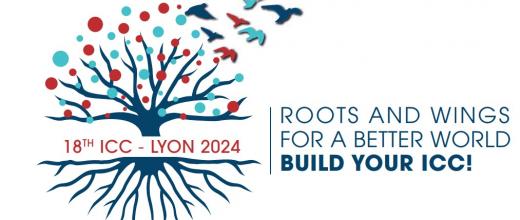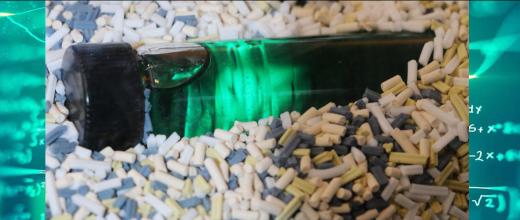08.03.2023
5 minutes of reading
 IFPEN owes its reputation for scientific excellence and capacity for innovation to the researchers, who put their expertise, but also their personality and their values into the work they do towards the green energy transition. Hélène Olivier-Bourbigou, the current head of program and overall coordinator of basic research at IFPEN, is one of those researchers. Recognized for her work in the field of catalysis, and particularly the development of more environmentally friendly processes, she is also known for her passion for building a community around the discipline.
IFPEN owes its reputation for scientific excellence and capacity for innovation to the researchers, who put their expertise, but also their personality and their values into the work they do towards the green energy transition. Hélène Olivier-Bourbigou, the current head of program and overall coordinator of basic research at IFPEN, is one of those researchers. Recognized for her work in the field of catalysis, and particularly the development of more environmentally friendly processes, she is also known for her passion for building a community around the discipline.
HOW DOES ONE BECOME AN INTERNATIONALLY RECOGNIZED EXPERT IN CATALYSIS?
Becoming an expert in catalysis and being recognized worldwide... I don’t think there’s any guide book that could be given for that! It’s an adventure on both a scientific and human level. An adventure that's challenging, but incredibly thrilling, and one which, for me personally, was made possible by a combination of deciding factors. First of all education, from early grade school through to university. Because although school may not give you a career, it does give you the tools to reach the highest level. From the start of my thesis, I was also lucky enough to meet men and women (there were very few women to begin with!) at IFP Energies nouvelles who gave me the tools to take a scientific approach that’s both rigorous and forward-thinking, as well as the passion, the drive, a determination and an appetite for risk, combined with high standards and a constant scientific curiosity. Later on, young women researchers who I had trained then gave me the drive to keep learning, to go further, and they’ve also contributed to this career.
I was also fortunate to meet, from the outset of my thesis, men and women at IFP Energies nouvelles who gave me the tools to take a scientific approach that’s both rigorous and forward-thinking
The exceptional research environment I found at IFPEN also played a huge part, because, from the start of my career, it allowed me to work towards the goal of developing more sustainable processes - a major economic and environmental challenge - by combining basic research and transfer to industry, while having the option of creating pathways between the disciplines. It was an asset that helped to establish me as a pioneer in the development of ionic liquids for catalysis.
Finally, I would mention the importance of communicating our work and innovations, whether it be in scientific publications or via conferences. They offer vital springboards that have enabled our approaches to gain the acclaim of the international catalysis community and be recognized with awards, for which I was merely a representative.
COULD YOU SHARE YOUR VISION FOR THE “CHALLENGES APPROACH”, THE FOUNDATION OF IFPEN'S BASIC RESEARCH?
>> IFPEN’s scientific challenges approaches in an infographic
When we present our scientific challenges approach outside of IFPEN, we get a lot of envy for it! It essentially provides us with a structural, cross-discipline and global perspective on our basic research. It allows us to project over the next 5, 15, 30 years, while connecting with IFPEN’s history by breaking down the barriers between disciplines and applied or more project-oriented themes. Ideally, we could say that it allows us to cross the thresholds of time and space!
But let's keep our feet on the ground and remember what makes it unique.
While the world of academia questions our understanding of phenomena in the strictly thematic or methodological terms of a given discipline, with benefits often applied over the long term, industry, at the heart of the market, is forced to seize on opportunities for innovation by short to medium-term performance targets. At the midpoint between these two perspectives, the challenges approach can allow us to create a bridge. I see it as essential in order to meet this ambitious challenge, which now requires that we successfully share and support the necessary risk-taking in the development of breakthrough innovations, for the sake of the sustainable world we want to see.
At the midpoint between these two perspectives [of academia and industry], the challenges approach can allow us to create a bridge. I see it as essential in order to meet this ambitious challenge, which now requires that we successfully share and support the necessary risk-taking in the development of breakthrough innovations, for the sake of the sustainable world we want to see.
On a more operational level, after experimentation, analysis and understanding of the phenomena, through physical-chemical and digital simulations, evaluation methodologies and systemic, economic, environmental and societal analyses, the challenges approach allows us to clarify the scientific questions, as well as the barriers to innovation created by the need for new technologies and society at large. It also enables us to apply methodological pathways in response, with a forward-looking perspective and an openness to breakthrough pathways.
As well as giving us long-distance, 360º vision, the challenges approach feeds our intellectual curiosity and is often the source of new ideas. A real asset, as the scientists are just as innovative in the way they do their research and in finding solutions!
WHAT DOES THAT MEAN IN THE DAY-TO-DAY?
Let's take batteries as an example. They are constantly evolving due to the growing needs of new uses and functionalities and they need to be higher-performing and safer. From the design of new materials/systems that are less critical and more easily recycled where possible, to the prediction of thermal runaway and ageing, how are we addressing these issues at IFPEN?
The challenges approach provides a point of entry, with a multi-physics and multi-scale method, including: ab initio approaches up to system level (challenge 6), the development of tools and methods for the development of new materials and the understanding of their associated electrochemical mechanisms (challenge 2), the study of phenomena at the liquid-solid or solid-solid interfaces (challenge 3) and finally the development of new tools for advanced analysis and characterization (challenge 1). Gaining a better understanding of batteries as part of a global approach then allows our engineers to find differentiating solutions, and additionally, to apply the learnings acquired to other energy storage systems, such as electrolyzers or even fuel cells, for new applications that meet the needs of society.
From the design of new materials/systems that are less critical and more easily recycled where possible, to the prediction of thermal runaway and ageing, etc. - how are we addressing these issues at IFPEN? The challenges approach provides a point of entry, with a multi-physics and multi-scale method [...]
Another example? The development and concrete proposal of a new innovative “bio/geo-inspired” project, similar to the better known bio-mimicry, as a result of cross-disciplinary scientific questioning and the cross-fertilization of skills in biotech and subsurface sciences.
For this global approach to work at its best, it will need more working together, more cross-fertilization of researchers’ experience and expertise. And that’s why IFPEN is appointing challenges managers, responsible for leading work groups made up of researchers from different areas of research. The managers have recently encouraged this dialogue more strongly by organizing challenge-specific discussion groups within IFPEN, which they opened up to all-comers. I’m pleased and proud of this successful initiative, which has prompted and encouraged scientific exchange, both within the challenge teams and with IFPEN R&I (Research and Innovation) as a whole and the experts of our Scientific Board, but also spread awareness of the challenges approach and enabled it to take root in the scientific landscape at IFPEN.
WHAT ARE THE PROJECTS THAT MOTIVATE YOU AND YOUR OUTLOOK ON THE FUTURE?
My greatest contribution is that which I’ve made towards achieving collective success, which I believe in. That involves passing on my expertise and scientific curiosity, a quality which I combine with a certain ability to take the time to question things, as the journey of reflection is just as important as the solution it leads to. What’s more, it involves sharing my undiminished passion for passing on my drive to others and celebrating that curiosity, which, along with the inventiveness of researchers, is threatened by the climate crisis that calls for rapid results. In a world where the search for meaning is sometimes muddled by incomprehension, and where uncertainty abounds, I feel that it’s important to share values.
My greatest contribution is that which I’ve made towards achieving collective success, which I believe in.
I’ve been honored to receive a number of scientific awards and honorary distinctions these last few years; now I hope in turn to support and challenge the youngest talent. When I was awarded Woman Scientist of the Year, people asked me what I had discovered. I realized how difficult it is to talk about our research in a way that’s simple and appealing. That's why I’ve always tried to make our work more accessible by increasing the opportunities for discussion with students (male and female) and teachers. It’s a side of my job that brings me a lot of joy. I’ve seen the impact we can have on the vocations we have the power to encourage. Young girls in particular can still be unsure about going into scientific fields. A little nudge from us can really be a game-changer!
The international influence of catalysis is another cause that’s close to my heart. I’m particularly proud to be co-chair of the forthcoming International Congress on Catalysis, which is being held in Lyon in 2024, and to be part of a dynamic team. It’s also the culmination of a shared journey, which started with the catalysis community when I took over as chair of the Catalysis Division of the Société Chimique de France (French Chemical Society) in 2013, and continues to this day.







